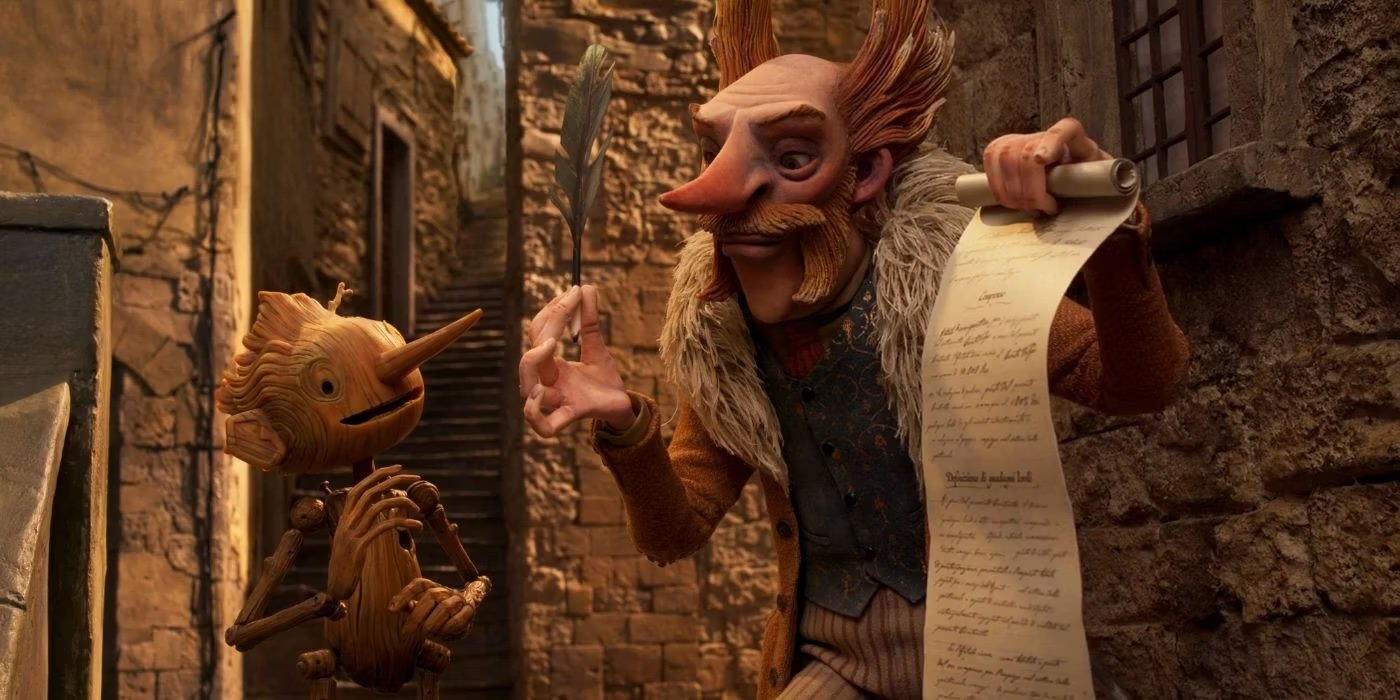
A innovative retelling to a classic in
Guillermo delToro’s Pinocchio
by Kathia Woods
Guillermo del Toro's Pinocchio may have been necessary in a year with many Pinocchio films, but it's also appropriate because the Mexican auteur's fingerprints are all over it. The fantastical elements and the exquisite craftsmanship of the stop-motion animation explains why he would want to tell it in this manner. He appears to be completely at ease with both the subject matter and the medium, and admiration can be gained even from a purely technical standpoint. While the original story was intended to be a moral for young boys, this retelling includes some significant changes that shift the story's focus away from the boys and toward their fathers. The film's raw strength will have an effect on audiences, but whether or not they feel the film's emotions may depend on whether they perceive themselves as a parent or a child.
This film is a love letter to healing and processing grief. The titular title may be the doll but the film is centered on Geppetto utilizing Pinocchio as his vehicle.
The film's highlight is (Ewan McGregor), who not only plays Sebastian J. Cricket but also narrates it. The presence of Mussolini reveals that the picture is set in Italy during World War II. David Bradley's Gepetto is a cheerful painter who is well-liked in his neighborhood and who is a doting parent to his son, Carlo (David Bradley). Sad to say, Carlo's death dampens Gepetto's enthusiasm. After many years, Gepetto has the notion to recreate Carlo in the form of a wooden boy while under the influence of alcohol. In Gepetton's effort to reunite with his son, he unwittingly gains Sebastian, who opens a shop in the tree from which he obtains firewood. He works feverishly to make the doll look like his dead son. As a result of his inebriation, he is unable to finish the doll and consequently nods off. In this version, Tilda Swinton plays the Wood Sprite/Death. After observing the Gepetto drive, she comes up with the idea of giving Gepetto's puppet life and making Sebastian's guide. To help him learn to be a responsible young man.
In delToro’s version Pinocchio still maintains his wooden appearance once he comes to life. Ostracized by the locals. Pinocchio's transformation into a boy is not going well. Cricket, seeing the impending disaster, agrees to be his guide in exchange for a wish. The new wooden boy is rough around the edges and in desperate need of direction. Soon another type of demon sees Pinocchio and immediately thinks of money. When Count Volpe (Christoph Waltz) meets Pinocchio, all he sees is profit. He promises him riches and fame. Furthermore, a supporter of El Duce Podesta sees him as a tool for propagandizing the war movement. The boy cannot be tamed because neither man understands the boy’s true needs.
Pinocchio, like all boys, wants to be loved and cared for and not be a puppet for anyone else regardless of the fact that he’s made of wood.
This is where this version differs; it's up to Geppetto to chase after Pinocchio and teach him the true meaning of love and grace and in turn learn those lessons himself. The film shows how having a bad father as a role model can lead boys to make bad decisions because in the end boys just want to not only be loved by their fathers but live up to their expectations.
A monkey named Spazzatura (Cate Blanchett).is another amusing character in the film. He is Volpe's right hand man, another being in search of love and acceptance. While Volpe is cruel to Spazzatura, it is the only true home he has ever known. Meanwhile, Podesta is attempting to turn himself into a miniature Mussolini, instilling in him the false illusion of what it means to be a patriot and fight for the Fatherland even as a child. Candlewick (Finn Wolfhard) is so named because Podesta regards him as weak and frail.
The emotional wounds from their troubled parent-child relationships cause Spazzatura and Candlewick, respectively, to be incredibly envious of Pinocchio.
Guillermo delToro and Mark Gustafson created a healing love letter. There are many symbols in the film, ranging from being a gracious father and helping your child be the best version of themselves to not using religion to advance fascism and the fact that one child cannot be used to replace another. It is also about allowing yourself to learn and grow.
Draped in amazing sets created by the team of Jesse Gregg, Gillian Hunt, Samantha Levy, Molly Light, Laura Savage and Zach Sheenan, it is a technical masterpiece. The stop motion animation lead by Ted Allen top tier. One can tell that a lot of care went into making this film.
It’s also a film that the whole family can enjoy.
Guillermo delToro proves once again why he is one of the premier masterminds of his generation that continues to surprise us.
Guillermo delToro’s Pinocchio comes to Netflix December the 9th


